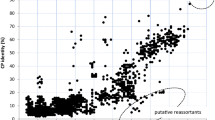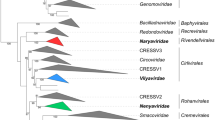Abstract
To study the outcome of natural selection using phylogenetic trees, we analyzed full-length genome sequences of porcine teschovirus (PTV). PTV belongs to the family Picornaviridae and has a positive-stranded RNA genome, the replication of which is carried out by the error-prone viral RNA-dependent RNA polymerase. The viral RNA encodes a single polyprotein that is cleaved into structural (i.e., L, VP4, VP2, VP3 and VP1) and nonstructural proteins (i.e., 2A, 2B, 2C, 3A, 3B, and 3C). A high degree of genetic diversity was found based on the pairwise nucleotide distances and on the mean ratio of the number of nonsynonymous (dN) and synonymous (dS) substitutions (dN/dS) in the structural genes. Conversely, the diversity of the nonstructural genes was lower. The differences in genetic diversity between the structural and nonstructural genomic regions were likely due to strong purifying selection; consequently, the estimates of phylogenies were also discordant among these genes. In particular, maximum-likelihood and Bayesian methods generated short-branched trees when loci that are under strong purifying selection were used. These findings indicate that even in an RNA virus with an intrinsically high mutation rate, a strong purifying selection will curb genetic diversity and should be considered an important source of bias in future studies based on phylogenetic methods.



Similar content being viewed by others
References
Hughes AL (2004) Phylogeny of the Picornaviridae and differential evolutionary divergence of picornavirus proteins. Infect Genet Evol 4(2):143–152. doi:10.1016/j.meegid.2004.03.001
Lewis-Rogers N, Bendall ML, Crandall KA (2009) Phylogenetic relationships and molecular adaptation dynamics of human rhinoviruses. Mol Biol Evol 26(5):969–981. doi:10.1093/molbev/msp009
Kistler AL, Webster DR, Rouskin S, Magrini V, Credle JJ, Schnurr DP, Boushey HA, Mardis ER, Li H, DeRisi JL (2007) Genome-wide diversity and selective pressure in the human rhinovirus. Virol J 4:40. doi:10.1186/1743-422X-4-40
Savolainen C, Laine P, Mulders MN, Hovi T (2004) Sequence analysis of human rhinoviruses in the RNA-dependent RNA polymerase coding region reveals large within-species variation. J Gen Virol 85(Pt 8):2271–2277. doi:10.1099/vir.0.79897-0
Tapparel C, Junier T, Gerlach D, Cordey S, Van Belle S, Perrin L, Zdobnov EM, Kaiser L (2007) New complete genome sequences of human rhinoviruses shed light on their phylogeny and genomic features. BMC Genomics 8:224. doi:10.1186/1471-2164-8-224
Leal E, Villanova FE (2010) Diversity of HIV-1 subtype B: implications to the origin of BF recombinants. PLoS One 5(7):e11833. doi:10.1371/journal.pone.0011833
Martins Lde O, Leal E, Kishino H (2008) Phylogenetic detection of recombination with a Bayesian prior on the distance between trees. PLoS One 3(7):e2651. doi:10.1371/journal.pone.0002651
Nguyen DV, Pham AH, Nguyen CV, Ngo HT, Carrique-Mas J, Vo HB, Campbell J, Baker S, Farrar J, Woolhouse ME, Bryant JE, Simmonds P (2013) Prevalence, genetic diversity and recombination of species G enteroviruses infecting pigs in Vietnam. J Gen Virol. doi:10.1099/vir.0.061978-0
Subramaniam S, Sanyal A, Mohapatra JK, Hemadri D, Pattnaik B (2011) Comparative complete genome analysis of Indian type A foot-and-mouth disease virus field isolates. Virus Genes 43(2):224–233. doi:10.1007/s11262-011-0622-8
Wilson Sayres MA, Lohmueller KE, Nielsen R (2014) Natural selection reduced diversity on human y chromosomes. PLoS Genet 10(1):e1004064. doi:10.1371/journal.pgen.1004064
Martin DP, Lemey P, Posada D (2011) Analysing recombination in nucleotide sequences. Mol Ecol Resour 11(6):943–955. doi:10.1111/j.1755-0998.2011.03026.x
Belshaw R, Gardner A, Rambaut A, Pybus OG (2008) Pacing a small cage: mutation and RNA viruses. Trends Ecol Evol 23(4):188–193. doi:10.1016/j.tree.2007.11.010
Bay RA, Bielawski JP (2011) Recombination detection under evolutionary scenarios relevant to functional divergence. J Mol Evol 73(5–6):273–286. doi:10.1007/s00239-011-9473-0
Wertheim JO, Kosakovsky Pond SL (2011) Purifying selection can obscure the ancient age of viral lineages. Mol Biol Evol 28(12):3355–3365. doi:10.1093/molbev/msr170
Mason RW (1970) Porcine polioencephalomyelitis associated with a serological response to porcine enterovirus F.26 in Tasmania. Br Vet J 126(6):xix–xx
Prodelalova J (2012) The survey of porcine teschoviruses, sapeloviruses and enteroviruses B infecting domestic pigs and wild boars in the Czech Republic between 2005 and 2011. Infect Genet Evol 12(7):1447–1451. doi:10.1016/j.meegid.2012.04.025
Salles MW, Scholes SF, Dauber M, Strebelow G, Wojnarowicz C, Hassard L, Acton AC, Bollinger TK (2011) Porcine teschovirus polioencephalomyelitis in western Canada. J Vet Diagn Invest 23(2):367–373. pii: 23/2/367
Zhang CF, Cui SJ, Hu S, Zhang Z, Guo Q, Zell R (2010) Isolation and characterization of the first Chinese strain of porcine Teschovirus-8. J Virol Methods 167(2):208–213. doi:10.1016/j.jviromet.2010.03.019
Deng MY, Millien M, Jacques-Simon R, Flanagan JK, Bracht AJ, Carrillo C, Barrette RW, Fabian A, Mohamed F, Moran K, Rowland J, Swenson SL, Jenkins-Moore M, Koster L, Thomsen BV, Mayr G, Pyburn D, Morales P, Shaw J, Burrage T, White W, McIntosh MT, Metwally S (2012) Diagnosis of Porcine teschovirus encephalomyelitis in the Republic of Haiti. J Vet Diagn Invest 24(4):671–678. doi:10.1177/1040638712445769
Boros A, Nemes C, Pankovics P, Kapusinszky B, Delwart E, Reuter G (2012) Porcine teschovirus in wild boars in Hungary. Arch Virol 157(8):1573–1578. doi:10.1007/s00705-012-1327-6
Cano-Gomez C, Palero F, Buitrago MD, Garcia-Casado MA, Fernandez-Pinero J, Fernandez-Pacheco P, Aguero M, Gomez-Tejedor C, Jimenez-Clavero MA (2011) Analyzing the genetic diversity of teschoviruses in Spanish pig populations using complete VP1 sequences. Infect Genet Evol 11(8):2144–2150. doi:10.1016/j.meegid.2011.09.014
Zell R, Dauber M, Krumbholz A, Henke A, Birch-Hirschfeld E, Stelzner A, Prager D, Wurm R (2001) Porcine teschoviruses comprise at least eleven distinct serotypes: molecular and evolutionary aspects. J Virol 75(4):1620–1631. doi:10.1128/JVI.75.4.1620-1631.2001
Drake JW (1993) Rates of spontaneous mutation among RNA viruses. Proc Natl Acad Sci USA 90(9):4171–4175
Hughes AL, Hughes MA (2007) More effective purifying selection on RNA viruses than in DNA viruses. Gene 404(1–2):117–125. doi:10.1016/j.gene.2007.09.013
Bizinoto MC, Yabe S, Leal E, Kishino H, Martins Lde O, de Lima ML, Morais ER, Diaz RS, Janini LM (2013) Codon pairs of the HIV-1 vif gene correlate with CD4+ T cell count. BMC Infect Dis 13:173. doi:10.1186/1471-2334-13-173
Woo J, Robertson DL, Lovell SC (2010) Constraints on HIV-1 diversity from protein structure. J Virol 84(24):12995–13003. doi:10.1128/JVI.00702-10
Mayrose I, Stern A, Burdelova EO, Sabo Y, Laham-Karam N, Zamostiano R, Bacharach E, Pupko T (2013) Synonymous site conservation in the HIV-1 genome. BMC Evol Biol 13:164. doi:10.1186/1471-2148-13-164
Hughes AL (2009) Small effective population sizes and rare nonsynonymous variants in potyviruses. Virology 393(1):127–134. doi:10.1016/j.virol.2009.07.016
Ngandu NK, Scheffler K, Moore P, Woodman Z, Martin D, Seoighe C (2008) Extensive purifying selection acting on synonymous sites in HIV-1 Group M sequences. Virol J 5:160. doi:10.1186/1743-422X-5-160
Larkin MA, Blackshields G, Brown NP, Chenna R, McGettigan PA, McWilliam H, Valentin F, Wallace IM, Wilm A, Lopez R, Thompson JD, Gibson TJ, Higgins DG (2007) Clustal W and Clustal X version 2.0. Bioinformatics 23(21):2947–2948. doi:10.1093/bioinformatics/btm404
Tamura K, Dudley J, Nei M, Kumar S (2007) MEGA4: molecular evolutionary genetics analysis (MEGA) software version 4.0. Mol Biol Evol 24(8):1596–1599. doi:10.1093/molbev/msm092
Lepage T, Bryant D, Philippe H, Lartillot N (2007) A general comparison of relaxed molecular clock models. Mol Biol Evol 24(12):2669–2680. doi:10.1093/molbev/msm193
Thorne JL, Kishino H, Painter IS (1998) Estimating the rate of evolution of the rate of molecular evolution. Mol Biol Evol 15(12):1647–1657
Drummond AJ, Suchard MA, Xie D, Rambaut A (2012) Bayesian phylogenetics with BEAUti and the BEAST 1.7. Mol Biol Evol 29(8):1969–1973. doi:10.1093/molbev/mss075
Drummond AJ, Rambaut A, Shapiro B, Pybus OG (2005) Bayesian coalescent inference of past population dynamics from molecular sequences. Mol Biol Evol 22(5):1185–1192. doi:10.1093/molbev/msi103
Tamura K, Nei M (1993) Estimation of the number of nucleotide substitutions in the control region of mitochondrial DNA in humans and chimpanzees. Mol Biol Evol 10(3):512–526
Yang Z (1996) Maximum-likelihood models for combined analyses of multiple sequence data. J Mol Evol 42(5):587–596
Yang Z, Rannala B (2005) Branch-length prior influences Bayesian posterior probability of phylogeny. Syst Biol 54(3):455–470. doi:10.1080/10635150590945313
Hicks AL, Duffy S (2011) Genus-specific substitution rate variability among picornaviruses. J Virol 85(15):7942–7947. doi:10.1128/JVI.02535-10
Jenkins GM, Rambaut A, Pybus OG, Holmes EC (2002) Rates of molecular evolution in RNA viruses: a quantitative phylogenetic analysis. J Mol Evol 54(2):156–165. doi:10.1007/s00239-001-0064-3
Takeda N, Tanimura M, Miyamura K (1994) Molecular evolution of the major capsid protein VP1 of enterovirus 70. J Virol 68(2):854–862
Martin DP, Williamson C, Posada D (2005) RDP2: recombination detection and analysis from sequence alignments. Bioinformatics 21(2):260–262. doi:10.1093/bioinformatics/bth490
Boni MF, Posada D, Feldman MW (2007) An exact nonparametric method for inferring mosaic structure in sequence triplets. Genetics 176(2):1035–1047. doi:10.1534/genetics.106.068874
Smith JM (1992) Analyzing the mosaic structure of genes. J Mol Evol 34(2):126–129
Posada D, Crandall KA (2001) Evaluation of methods for detecting recombination from DNA sequences: computer simulations. Proc Natl Acad Sci USA 98(24):13757–13762. doi:10.1073/pnas.241370698
Sawyer S (1989) Statistical tests for detecting gene conversion. Mol Biol Evol 6(5):526–538
Bay RA, Bielawski JP (2012) Recombination detection under evolutionary scenarios relevant to functional divergence. J Mol Evol. doi:10.1007/s00239-011-9473-0
Kosakovsky Pond SL, Frost SD (2005) Not so different after all: a comparison of methods for detecting amino acid sites under selection. Mol Biol Evol 22(5):1208–1222. doi:10.1093/molbev/msi105
Muse SV, Gaut BS (1994) A likelihood approach for comparing synonymous and nonsynonymous nucleotide substitution rates, with application to the chloroplast genome. Mol Biol Evol 11(5):715–724
Pond SL, Frost SD, Muse SV (2005) HyPhy: hypothesis testing using phylogenies. Bioinformatics 21(5):676–679. doi:10.1093/bioinformatics/bti079
Goldman N, Anderson JP, Rodrigo AG (2000) Likelihood-based tests of topologies in phylogenetics. Syst Biol 49(4):652–670
Suzuki Y, Glazko GV, Nei M (2002) Overcredibility of molecular phylogenies obtained by Bayesian phylogenetics. Proc Natl Acad Sci USA 99(25):16138–16143. doi:10.1073/pnas.212646199
Tajima F (1989) Statistical method for testing the neutral mutation hypothesis by DNA polymorphism. Genetics 123(3):585–595
Yang Z, Nielsen R, Goldman N, Pedersen AM (2000) Codon-substitution models for heterogeneous selection pressure at amino acid sites. Genetics 155(1):431–449
Comeron JM, Kreitman M, Aguade M (1999) Natural selection on synonymous sites is correlated with gene length and recombination in Drosophila. Genetics 151(1):239–249
Kryazhimskiy S, Bazykin GA, Dushoff J (2008) Natural selection for nucleotide usage at synonymous and nonsynonymous sites in influenza A virus genes. J Virol 82(10):4938–4945. doi:10.1128/JVI.02415-07
Williamson S, Orive ME (2002) The genealogy of a sequence subject to purifying selection at multiple sites. Mol Biol Evol 19(8):1376–1384
Author information
Authors and Affiliations
Corresponding author
Ethics declarations
This article does not contain any studies with human participants or animals performed by any of the authors. E.L. was supported by the Fundação de Amparo e Desenvolvimento da Pesquisa (FADESP) and Pró-Reitoria de Pesquisa e Pós-Graduação (PROPESP) (grant no. 11/2015). S.C. was funded by the National Natural Science Foundation of China (Grants No. 31001069, No. 31172349, and No. 31172341). The authors declare that they have no conflict of interest.
Rights and permissions
About this article
Cite this article
Villanova, F., Cui, S., Ai, X. et al. Analysis of full-length genomes of porcine teschovirus (PTV) and the effect of purifying selection on phylogenetic trees. Arch Virol 161, 1199–1208 (2016). https://doi.org/10.1007/s00705-015-2744-0
Received:
Accepted:
Published:
Issue Date:
DOI: https://doi.org/10.1007/s00705-015-2744-0




